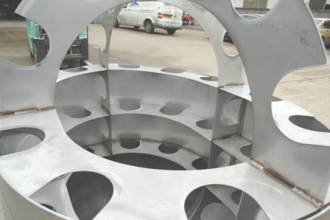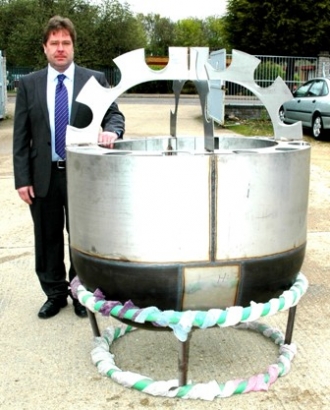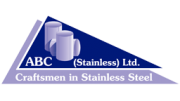Funny how BLOODHOUND can bring back memories. Sometimes apparently very unrelated memories.
When we moved into our last house 30 years ago it was one of those joints which estate agents describe as ‘having potential’. Which decodes as: ‘It’s a complete shambles right now, but if you’re prepared to pour another 50% of the purchase price into it you might have some faint chance of making something remotely habitable by human beings. You must also be of optimistic disposition”.
Well, it was the location that did it – lovely Chiltern Hills aspects front and back. We had the kitchen changed dramatically, creating a huge new window to look out the back…
At the gorgeous vista of a damn great heating-oil tank spang outside the new window.
Well of course we had plans to move it. It was going into a niche behind the garage, and in fact Bob the Builder had already constructed a brick-built plinth for it.
“Okay Bob”, says I. “Time to move the oil tank”.
“Can’t be done”, says Bob.
“Whatdja mean can’t be done? You said you could do it”.
“Yeh. But that’s a 250 gallon tank, that is. 1,130 litres. And it’s half full. Can’t move it while it’s half full. Any idea what that weighs?”
Even I could work that out. Heating oil – more or less red diesel fuel, though not quite exactly the same – has a specific gravity of about 0.82. That means that 250 gallons of it weighs over 2,000 lbs – 900-plus kilos. Say about 12 average people. So half full – say, six people. Plus the weight of the tank itself, which would not be inconsiderable.
“So get a crane in”.
“Yeh, we can do that, Guv’nor. But it’s comin’ out of an awkward space an’ into another awkward space. And tanks is ‘orrible things to lift if you’ve got anythin’ in ‘em ‘cos it sloshes backwards and forwards, dunnit? So yer need a big crane. Cost yer abart a grand”.
I put my hand in my pocket and discovered, unsurprisingly, nothing there but fingers.
“Can’t afford another grand, Bob”.
“So empty the tank. Call me when you’ve done it and I’ll bring a big gang along and we’ll carry it. Seeya…”
I liked Bob the Builder. It was only on rare occasions, in day-dreaming mode, that I sometimes thought about personally integrating his skeleton into the structure of the house. But he did have a point.
Only thing was, that during the summer it could easily take three months or more to use up half a tank of heating oil. So I then embarked on the rather ludicrous process of trying to give away some 600 litres of red diesel. Roll up, roll up – red diesel, free, gratis, and for nuffink! Recipient collects…
No takers.
A couple of local farmers would be happy to have it – but had no means of pumping it out. The heating oil delivery people could pump it out – but wouldn’t. “Sorry Sir, but that’s been in your tank. It could be contaminated. Can’t risk pumping that into one of our tankers…”
So in the end I sold it to myself – or rather to my small company. At the time we were operating three aerobatic display aeroplanes, each of which had a smoke system which worked by pumping diesel into the engine exhaust at a rate of just over two litres a minute. We normally used ‘white’ diesel – road-going diesel, full duty paid and all. But cautious experimentation revealed that red diesel was almost as good, especially when slightly laced with – oh, never mind. Each aeroplane used just over 20 litres per display. And we were booked for some 130 displays over the season, both duo and solo. So I bought six 25-litre jerry cans…
If you use red diesel in a road-going vehicle it immediately stains the fuel system red – which is the whole purpose of the red dye – and if the Diesel Police catch you at a roadside stop they will immediately cast you into the Bastille for the desperate crime of trying to run a haulage business without paying criminally savage fuel taxes. I glanced through the regulations and found – oddly enough – no reference to aircraft smoke systems. Remiss of them. But if it doesn’t say don’t do it then obviously you can do it…
Ten days later I rang up Bob the Builder and said; “Tank’s empty, Bob. Come and move it”.
“Blimey!” says Bob. “That was quick. Howdja do that?”
“I decline to discuss the matter. Just come and move the ruddy tank”.
That was when the fun started.
Because you can’t in all practicality totally empty any domestic 1,100 litre tankfull of anything. Because all the outlets are a bit above the bottom of the tank so that any accumulation of sludge doesn’t get sucked into the system. The bit at the bottom is called ‘unusable fuel’. In this case maybe about 50 litres.
Doesn’t sound much. The weight of one fairly small human being. But if you’ve got six hefty guys lifting a tank and it gets tilted forwards by even one degree, the unusable fuel rolls down the front. The strong-arm guys at the front grunt and give it an extra heave – and the unusable promptly surges to the back. So the guys at the back do the same thing and the unusable surges to the front again…
The upside is that the process of moving such a tank can be quite funny to watch so long as you’re not personally one of the strong-arm guys trying to do the lifting. I, being the runt of the litter, am not doing any lifting, and most carefully avoid all expressions of mirth on the grounds that any one of the lifters is approximately twice my weight and size and could probably render me extinct with one swing of a ham-like hand. So I simply observe. And crack open six beers.
Cut to BLOODHOUND
Cut to now. And BLOODHOUND.
Specifically, cut to BLOODHOUND’s High Test Peroxide (HTP) tank, which I am currently staring at in some awe. You may intellectually know that the HTP tank will have a capacity of 963 litres – but knowing it is most distinctly not the same as seeing it. In the flesh – or rather stainless steel – it is… well, enormous. Roughly the size of my long-ago heating oil tank. In the car it will of course be horizontal but right now, still under construction, it sits vertically on a cradle and the top of it is above my head.
It is also – or will be when finished – a significantly more elegant shape than my old tank, having four neatly-rounded corners and the general air of a seriously-designed pressure vessel.
Which of course it must be, it being designed to cope with certain small technical traumas which my heating tank had not quite had in mind. For a start it will be operating at nearly twice atmospheric pressure, courtesy of nitrogen pressurisation. And then, despite being slightly smaller than my old tank, the contents will be notably heavier because HTP has a Specific Gravity of 1.35, so a whole tank-full will be carrying 1,270 kg (2,800 lbs) of liquid.
(In fact the idea is to carry only 1,107 kg – theoretically enough for a 1,000 mph run including 15% ullage – but in record-breaking you never knows what might finally transpire. And if what finally transpires is that you could actually do with another 160 kg of HTP – a mere weight of two average people – you are going to feel a bit of a mumbo if there isn’t room for it in the tank).
And then there is the matter of slosh. This is directly related to the slosh which made my building team stagger so entertainingly three decades ago – but, er, kinda more significant. If you’d subjected my old tank to twice atmospheric pressure and then 3G of acceleration the back wall would certainly have collapsed. If you’d used up most of the contents but then subjected it to 3G deceleration the consequences – odd as it may sound – could be equally dire to the front bulkhead, because the pressure-wave would be less damped and thereby produce a most significant spot-load. In aircraft aspiring to great agility this is called fuel-slam, and is a great pain in the ass to designers because they know full well that once they’ve stressed the tank for all the loads they can think of plus a huge safety factor, some bone-headed but enterprising pilot will find some new gyration which exceeds the limits, and then complain when the end-plates start to leak. Or just plain give way. Assuming the enterprising pilot is still extant and in a condition to complain, which he may not be if all of one inboard wing-tank’s fuel has suddenly arrived at the wing-tip.
One very strong tank
So BLOODHOUND’s HTP tank has got to be one strong tank. Very strong.
From where I’m standing in the factory of ABC Stainless Ltd in Peterborough, it looks like the strongest tank I’ve ever clapped eyes on. It is made of stainless steel – as the company name implies – and because it is not yet complete I can see the tank baffles inside of it. These baffles are there to both strengthen the structure and also to… well, er, baffle any fuel-slam, so it doesn’t happen quite so quickly as it would in a completely hollow tank.
Designing these baffles is inevitably a bit of an engineering juggling act. If there were no baffles then a sudden fuel-slam could seriously upset BLOODHOUND’s stability – much, much more seriously than any fuel-slam wound up my builders. But if you have too much in the way of baffling… then it will impede the outflow of HTP to the pump and thereby the rocket. Which could conceivably cause the pump to cavitate and surge, which is most definitely Not Good For It. And in turn not good for a stable rocket-burn. And wouldn’t much cheer up a Cosworth engine running at full grunt either…
I slowly walk round this behemoth of a tank. If it was full of red diesel it would run the heating and hot water systems of a good-sized house for about five months.
In BLOODHOUND it is going to be emptied in 20 seconds.
It will in fact be neutral for the environment. This much red diesel is an average household pollutant, whilst HTP is basically double-oxygenated water and therefore no atmospheric pollutant whatsoever under any circumstances. (Despite any rumour to the contrary which you might have read in a few lines from the highly erudite and deeply-researching editorial team of The Sun newspaper in a moment’s relaxation from the rigours of editing Page Three). But never mind that. Just think of emptying five month’s volume in 20 seconds…
Okay, it’s got several factors going for it. There’s the Stentor-based rocket pump itself, obviously, (see From Cold War to Car) then the fact that the tank’s pressurised. Then the further fact that the outlet is 108mm (4.25 ins) in diameter – notably larger than your average drainpipe – plus the location of the tank in front of the pump with said outlet at the rear, so that fuel-slam under 3G acceleration will also help matters along.
But all the same…
Look at the pictures of it. Imagine a tank that size being very nearly drained in 20 seconds…
 Baffling the fuel-slam. This is just for the rocket test programme – the final baffles may be more complex
Baffling the fuel-slam. This is just for the rocket test programme – the final baffles may be more complex
 The HTP tank in mid-construction. Not a pretty sight at this stage, but the satin polishing will come later after adding the second end. For comparison Mark McAuliffe, standing beside it, is some 6 feet tall…
The HTP tank in mid-construction. Not a pretty sight at this stage, but the satin polishing will come later after adding the second end. For comparison Mark McAuliffe, standing beside it, is some 6 feet tall…
Not for the first time in my association with BLOODHOUND, I find myself bereft of intelligent things to say. After a long moment, drawing on my vast engineering knowledge and chimerical degree from the University of Life, I find a profound utterance.
“Er… looks like a bloody strong tank, Mark…”
“Yes, it is”. Mark McAuliffe is the Technical Director of ABC Stainless, and 50% owner of the company along with his partner Justin Woolner. “I don’t think”, says Mark, “that either BLOODHOUND or Cosworth could find a way of breaking that”.
I am inclined to agree. In fact – as a non-expert – I get the general feeling that you could chuck a hand-grenade into it and all it would do is contain the detonation and burp genteelly. Or possibly rather echoingly.
Mark and Justin are in fact archetypal BLOODHOUND Product Sponsors. ABC Stainless is not a huge company. It has about 30 employees, which in soulless Government-speak I suppose makes it an SME – a Small / Medium Enterprise. Governments do not however possess graphs by which they can measure the spirit and quality of a company.
I know very little about stainless steel fabrication. But I do know what a cheerful and dedicated team looks like, and this is one of them. In spades. Mark and Justin, both engineering-trained, worked for ABC for a period and then three years ago took deep financial breaths and carried out a management buy-out from the founder, who wished to retire. Since then the company has prospered and grown in a nice controlled fashion. They make everything from stainless steel hand-railings to tanks and pipe-work for the petrochemical, pharmaceutical, and food and drinks industries. Their products are beautifully finished and have a reputation for being tough as old boots. In short, they are enthusiasts.
They are both, also, unashamed petrol-heads. Mark was a kart-racer in his youth and graduated to – of all things – being ‘passenger’ on a grass-track racing sidecar outfit, which has to cast certain doubts on anybody’s sanity. Now 44 and the father of three he has – pardon me, Mark – slightly thickened into executive mode perhaps a little beyond sidecar duty, but is still a motor sport enthusiast. Justin, at 35, is the hands-on Works Director, usually to be found with welding-torch in paws and a determined look on his swede. He used to be a most formidable banger-racer, being slightly famous for buying a Rolls Royce, stripping out all the decent bits and selling them at a profit – although what decent bits you get out of a Rolls Royce without the Rolls Royce attached to them is a bit of a mystery to me – and then racing the remains. He used to live in a small house and drive a Lamborghini Murcielago as an everyday car. But he recently married, bought a bigger house – and anybody wanna buy a Lambo, never raced or rallied?
Enthusiasts.
In ’09 they visited the Goodwood Festival of Speed, and Justin found himself in the BLOODHOUND marquee. As it happens I didn’t meet him, but have a certain proprietorial interest, having nearly broiled my brains out doing internal assembly of the Show Car at that same Festival. (see To Create Something Special). When I wrote about the Festival I made a comment to the effect that who knew how many Managing Directors might have wandered into the marquee, absorbed the Project, then after a week’s mulling picked up the phone to offer something – which is almost exactly what Mark and Justin did.
Why? Well, it sounds glib to say ‘for all the usual reasons’ – but so many Product Sponsors tell me so many of the same reasons that it’s difficult to imagine they aren’t all spiritually joined at the hip. There’s publicity, of course, plus the ability to use the BLOODHOUND logo on stationery, etc. For ABC this is a nice-to-have, but not a must-have. They are already well-known and respected in their niche industry, they’re well-known to their customer-base, and currently have no plans whatsoever for producing stainless steel chocolates or stainless steel underpants and marketing them to the masses. So publicity? Yeah – slight yawn – now where were we…?
Other motives? Love a technical challenge… do our bit to inspire the next generation of engineers… fiercely patriotic and want to see Britain leading in technology instead of lagging… very vivid memories of Thrust 2 and Thrust SSC…
And above all simply wanting to be a part of the adventure.
Some play a part by volunteering for stone-picking on the Hakskeen Pan. Some medium but quietly successful and in fact very important company directors volunteer by saying; “Look, we have this particular expertise. What can we do to help?”
Which brings us back to this enormous tank.
And to me asking Mark a question to which I already know the answer.
“Could this tank go in the car?”
“Theoretically, yes. The baffles may not be ideal and they need proving by testing. It’s certainly adequately stressed – in fact it’s almost certainly far stronger than it needs to be. Which also means it’s heavier than it needs to be”.
That it is. This tank weighs 160 kg empty – roughly two people, and almost exactly twice BLOODHOUND’s design target weight for the final (empty) tank. A Teflon-carbon filament-wound tank – whatever the heck a Teflon-carbon filament is – would I’m told hit the 80 kg weight target. Probably.
Mark is perfectly well aware of this.
I ask; “So this tank is just for the rocket tests with Cosworth?”
“Oh, yes. Weight doesn’t matter there”.
“Could you build it lighter?”
“Ye-es…” Mark rocks his hand. “Somewhat lighter. We’ll know after the trials”.
“So you’re quite happy to regard this one as a trial, and re-make the whole thing again?”
“Certainly. If that’s the way BLOODHOUND wants to go. They may want to go with composites. We don’t know yet. They have to find the lightest tank, and stainless might not be it. We’ll see how it goes”.
Okay. Let me run over this. Mark and Justin are making – or have probably completed by the time you read this – this huge tank, and also various other things for BLOODHOUND. Such as the ice-cooling tank for the Cosworth engine, and contrarily also the water heating tank for pre-heating the Cosworth before it’s started up, it being a bit picky in these matters. They are also producing a lot of very high-tech pipery.
But the HTP tank they’ve created may well not be the final edition…
The brightness of midday pours into ABC’s conference room as I ask the last, inevitable, question which I must ask as a commentator. Although again I know what the answer will be.
“Mark – what’s this costing you?”
“Look – I don’t know. We’re not costing this out. Probably about £10,000…”
Which could mean up to £30,000 at the end of the day.
How many times have I heard this from Product Sponsors? “We’re not costing it out”. Which decodes that within reason ”I don’t wanna know – we’re just gonna do it anyway”.
World, look at these people. Britain, look at these people. These are the people with the balls to catch the BLOODHOUND spirit and be inspired by it. If I was buying product or shares, I damn sure know which companies I would go for.
I have singled one out here, which is always unfair. But it’s a good example. I just regret that being a wee tad past the executive lunch-time of life, I am not going to be volunteering to lift up the HTP tank…



